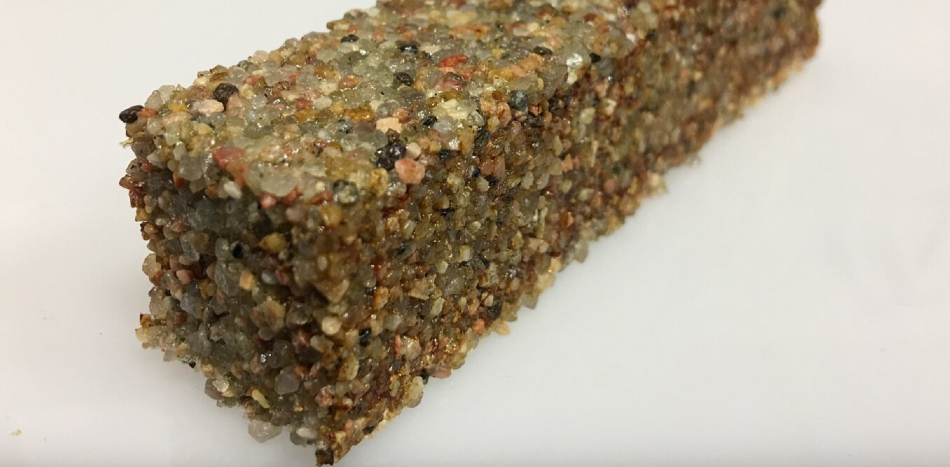
A block of sand particles held together by living cells. Image Credit: The University of Colorado Boulder College of Engineering and Applied Science
A new study has demonstrated how buildings could be constructed, maintained, and repaired by living materials. A team at the University of Colorado Boulder published their findings this week in the journal Matter, where they describe how they used genetic engineering to develop structural building material from photosynthetic cyanobacteria.
This work is likely to be significant in the development of next-generation green building materials that will reduce the emissions of the construction industry.
Using Genetic Engineering to Create Building Materials
The US team has, for the first time, shown that calcium carbonate (CaCO3) can be manipulated to create living building material by using genetic engineering to amend the precipitation kinetics of cyanobacteria (a type of ureolytic microorganism).
While there are already a number of applications in the field of engineering that leverage microorganisms to generate CaCO3, thus far none of these applications have demonstrated a method of control over the morphology and material properties of bacterial calcite.
A previous study used genetically programmed the bacteria E.coli to generate particles of limestone in different shapes and sizes with different levels of toughness and stiffness. Another study demonstrated that E. coli can be genetically manipulated to cause it to create styrene, which is used to make polystyrene foam.
Reducing Emissions with Living Materials
The current study created a living structural building material using photosynthetic cyanobacteria. Cyanobacteria are organisms that are similar to algae and naturally, they construct themselves into large wall-like structures, such as those found on the sides of fish tanks. What’s useful about cyanobacteria is that they convert carbon dioxide into sunlight, using it to fuel growth, rather than emitting it. It can also be used to help bond sand particles to one another, creating a living brick substance.
The team kept the cyanobacteria alive, allowing them to create expanding volumes of building materials. For example, the team was able to split one living brick in two, and from those two halves, they grew two full bricks, splitting each in half again to grow four full-sized bricks, exponentially growing the building material. With this method, researchers were able to grow numerous bricks simultaneously, an innovation in the manufacture of building materials.
The researchers believe that this innovation marks just the beginning of what will be achieved with engineered living materials. There is much more work to be done. The potential of other organisms still needs to be explored, as different bacteria may have the capacity to create different kinds of materials. Those of particular interest will be materials that heal themselves or can respond intuitively to the environment.
What’s important about this breakthrough is that living materials can be created using far less energy than traditional ones, meaning that the carbon footprint of living materials is lower. The widespread adoption of these materials could, therefore, bring down the high levels of emissions attributed to the construction industry. The cement industry alone produces 8% of the world’s carbon dioxide emissions, therefore, replacing conventional building materials with living materials could have a significant impact.
Changing Perceptions
Living construction materials is an emerging field that still needs to be fully explored. In the coming years, we can expect much more research to be conducted to investigate how other microorganisms can be used, and how these materials can be developed ready for commercial use.
Acceptance of the materials is likely to be a major barrier to widespread adoption, with those in the construction industry unlikely to readily switch to a new generation of materials that they are not familiar with. Changing the perceptions of the construction industry, therefore, will also be a major research focus alongside developing the materials themselves.
Disclaimer: The views expressed here are those of the author expressed in their private capacity and do not necessarily represent the views of AZoM.com Limited T/A AZoNetwork the owner and operator of this website. This disclaimer forms part of the Terms and conditions of use of this website.